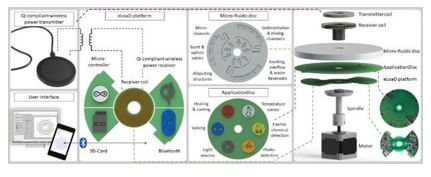Poster Abstract
Saraí M. Torres Delgado, Jan G. Korvink1 and Dario Mager*
Karlsruhe Institute of Technology – IMT, Eggenstein – Leopoldshafen, 76344, Germany
Tec.Nano 2019
Over the last decade centrifugal microfluidic platforms have been of increasing interest for use in decentralized bioanalytical testing such as point-of-care diagnostics. This technology is particularly powerful due to the inherent ability to centrifuge samples like the ones required for blood processing. However, while the LoaD technique compared to LOC, has simplified basic operations such as valving, pumping, metering, mixing and sample preparation, solutions to other arising needs, such as the integration of (active) operations, or the readout of a bioassay result, has proven more challenging to achieve when the platform is under continuous rotation, a characteristic inherent to their working principle. As anyone can foresee, power and signal cables cannot be connected to a rotating system, because they will twist, entangled, and finally, disconnect or brake, hampering the integration of actuators and/or detectors into the system. These components are needed for a sensitive, reliable, time-independent, fast, direct and continuous interaction with the microfluidic disc while spinning and, thereby, enhancing the success of LoaD systems.
Hence, here we present the design and development of a low cost, compact and portable platform that co- rotates with the microfluidics disc, called the “electrified Lab-on-a-Disc (eLoaD) platform” which includes all modules necessary for it to be used in any diagnostic assay. Because it requires power, wireless energy transmission was introduced into the system. Hence, the platform was designed and fabricated to behave as a wireless power receiver compatible with the Qi standard, better known for its use in wireless charging of consumer electronic devices. Since most envisaged applications will require a control unit that provides enough computational power, a way to record data and real-time bidirectional communication between the user and the ongoing experiment, the platform comprises an Arduino microcontroller, an SD-Card and a Bluetooth module. The inclusion of those modules renders a flexible platform, easy to operate for most users with backgrounds ranging from biology to engineering and compatible with concurrently emerging trends and standard technologies.
As any laboratory that operates on basic and specialized equipment, the capabilities of the proposed system can be augmented by the addition of a second electronic board plug-compatible to the eLoaD. This additional board referred to as Application Disc in Fig. 1 contains the application-specific sensors and actuators. Such scheme leads to a higher degree of interaction and enables more sophisticated concepts to be implemented both in the control as well as in the readout. The performance of the platform was tested under several sensing and actuation experiments (1-3), some of which will be presented at the conference.

Figure 1: Integration of the wireless centrifugal system into conventional LoaD systems. A commercially available Qi-compliant transmitter is inductively coupled to the eLoaD platform. This fully integrated platform can control sensors and actuators located on the Application Disc, which itself is simultaneously interacting with the microfluidics disc. The disposable microfluidic disc and the reusable Application Disc are typically designed for a particular application, whereas the eLoaD platform, which implements the control logic, power, and communication, is reused as a generic framework for all possible applications. Interfacing of the eLoaD platform is enabled by Bluetooth communication, here exemplary via an Android application program running on a portable device, and from a PC running e.g. a LabVIEW script.
REFERENCES
(1) S. M. Torres Delgado et al., Lab Chip, vol. 16, no. 20, pp. 4002-4011, 2016.
(2) S. M. Torres Delgado et al., Biosensors and Bioelectronics, vol. 109, pp. 214 – 223, 2018.